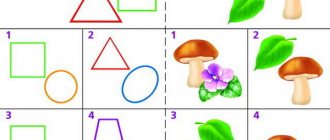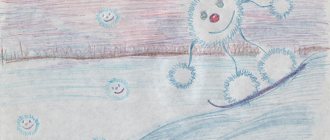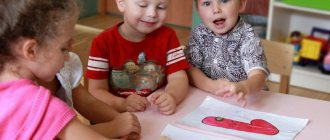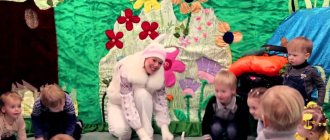Development of artistic and creative abilities of preschool children.
Berezenko Anastasia Alexandrovna
Development of artistic and creative abilities of preschool children.
Development of artistic and creative abilities of preschool children
Content:
Introduction
1. Relevance and significance of the development of artistic and creative abilities
2. Theoretical foundations of research on children’s creativity (psychological and pedagogical research on the problem of creativity)
3. Features of manifestation of creativity before schoolchildren
4. Development of creativity of preschoolers in the design of natural materials
5. Final experiment - lesson notes
Introduction:
The development of artistic and creative abilities is not a new subject of research. The problem of human abilities has aroused great interest among people at all times. However, in the past, society did not have a special need to master people's creativity. Talents appeared as if by themselves, spontaneously creating masterpieces of literature and art: making scientific discoveries, inventing, thereby satisfying the needs of the developing human culture. Nowadays, the situation has changed radically. Life in the era of scientific and technological progress is becoming more diverse and complex. And it requires from a person not stereotyped, habitual actions, but mobility, flexibility of thinking, quick orientation and adaptation to new conditions, a creative approach to solving large and small problems. If we take into account the fact that the share of mental labor in almost all professions is constantly growing, and an increasing part of the performing activity is being transferred to machines, then it becomes obvious that a person’s creative abilities should be recognized as the most essential part of his intelligence and the task of their development is one of the most important tasks in the education of modern man. After all, all cultural values accumulated by humanity are the result of people’s creative activity. And how far human society will advance in the future will be determined by the creative potential of the younger generation.
The purpose of this study is
• studying the problem of developing the artistic and creative abilities of preschool children , namely those aspects of it, the knowledge of which is necessary for practical activities in this direction for kindergarten teachers and parents.
• determination of conditions favorable for the development of children's creative abilities .
Children's creativity is based on imitation, which serves as an important factor in the development of the child , in particular his artistic abilities . The teacher’s task is, based on children’s tendency to imitate , to instill in them the skills and abilities without which creative activity is impossible, to cultivate in them independence, activity in the application of this knowledge and skills, to form critical thinking and focus.
It is known that children's creativity is a unique phenomenon. Many teachers and psychologists, both domestic and foreign, emphasize the great importance of artistic creativity in the all-round, especially in the aesthetic development of the child’s personality .
The visual activities of preschoolers contain great potential for the comprehensive development of the child . However, these opportunities can only be realized when children feel joy and satisfaction from what they have created, if the creative process puts them in a good mood.
Drawing for a child is a unique form of knowledge of reality, the surrounding world, comprehension of artistic art , and therefore requires in-depth study, prediction and correction of children's . Drawing is perhaps the most interesting activity for preschool children . We believe that due to the insufficient development of figurative speech , children express their feelings and ideas about what they see more deeply in their drawings than in words.
“The origins of children’s abilities and talents are at their fingertips. From the fingers, figuratively speaking, come the finest threads - streams that feed the source of creative thought. In other words, the more skill in a child’s hand, the smarter the child,” said V. A. Sukhomlinsky. visual arts activities are so important in preschool age They serve to improve art education and aesthetic education of children . It is necessary to teach children to see beauty , to understand and appreciate works of art, the beauty and richness of their native nature.
Fine art activities include drawing, appliqué, and modeling.
Psychological and pedagogical research, as well as the practice of our kindergartens, prove that the beginning of the development of children's creative abilities falls at preschool age , when the nature of their activities changes compared to early childhood. Unlike adults, children are not able to think through the upcoming work in all details; they outline only a general plan that is implemented in the process of activity. The teacher’s task is to develop the child’s creative abilities , purposeful imagination, and encourage him to move from thought to action in any activity.
From a psychological point of view, preschool childhood is a favorable period for the development of creative abilities because at this age children are extremely inquisitive, they have a great desire to explore the world around them. And parents, by encouraging curiosity, imparting knowledge to children, and involving them in various activities, contribute to the expansion of children's experience. And the accumulation of experience and knowledge is a necessary prerequisite for future creative activity
One of the most important factors in the creative development of children is the creation of conditions conducive to the formation of their creative abilities .
The second important condition for the development of a child’s creative abilities is the creation of an environment that advances the development of children
The third, extremely important, condition for the effective development of creative abilities follows from the very nature of the creative process, which requires maximum effort.
The fourth condition for the successful development of creative abilities of one activity, in choosing methods, etc. d.
It has long been known that creativity requires a comfortable psychological environment and the availability of free time, therefore the sixth condition for the successful development of creative abilities is a warm, friendly atmosphere in the family and children's team.
But creating favorable conditions is not enough to raise a child with high creative potential, although some Western psychologists still believe that creativity is inherent in the child and that one should just not interfere with his free expression. But practice shows that such non-interference is not enough: not all children can open the way to creativity and maintain creative activity for a long time.
Thus, speaking about the problem of children's creative abilities , I would like to emphasize that their effective development is possible only with joint efforts from both preschool and the family.
The creative process is a special form of qualitative transition from the already known to the new, unknown. In children, this transition occurs in the process of various forms of search activity aimed at solving new, unusual problems for the child. One of the important forms of search activity is the so-called children's experimentation. This is a truly childish independent activity of preschoolers , arising at an early age and intensively developing throughout preschool childhood.
children’s natural curiosity are manifested and developed , and the most effective part of the child’s individual experience is formed.
Children's creativity is always full of bright positive emotions. And thanks to this circumstance, creativity has a great attractive force for preschoolers who have known the joy of their first, albeit small, but discoveries, the pleasure of their new drawings, buildings, etc.
Among arts and crafts, children love to engage most in fine arts, in particular, children's drawing.
By the nature of what and how a child portrays, one can judge his perception of the surrounding reality, the characteristics of memory, imagination, and thinking. Sewing and knitting classes play a major role in the development of children’s creative abilities Having studied the basics of knitting, children combine patterns themselves and take a creative approach to making the product. Having cut out the product for themselves, the children select a design for the product, based on the color scheme. In the process of such activities, children develop logical thinking and creative imagination.
Music occupies an important place in . Children enjoy listening to music and repeating musical lines and sounds on various instruments. At preschool age, for the first time, an interest in serious music studies arises, which can later develop into a real passion and contribute to the development of musical talent. Children learn to sing and perform various rhythmic movements to music, in particular dance movements.
Vocal classes are also a creative activity. Singing develops an ear for music and vocal abilities .
To reveal creative abilities , collectively performed etudes and music and dance improvisations are used.
4. Development of creativity of preschoolers in the design of natural materials
Drawing is popular among preschool children aged 4-5 - 6.5 years. By drawing, the child shows his desire to understand the world around him, and from the drawing, to a certain extent, one can determine the level of this knowledge. The more developed children's perception and observation skills are, the wider their stock of ideas, the more fully and accurately they reflect reality in their creativity, the richer and more expressive their drawings. The visual activities of 6-year-old children reflect such specific features of their thinking as concreteness and imagery. The visual activity of a child is closely connected not only with individual functions (perception, memory, thinking, imagination, but also with the personality as a whole. It reveals the child’s interests, temperament, and some gender differences.
Modeling allows you to depict objects in three-dimensional space. During sculpting, a child can convey the shape of a person, animals, birds, fruits, dishes, etc. It is valuable that the properties of the materials used in sculpting make it possible to repeatedly change the shape, achieving the desired expressiveness. It is the development of the ability to convey the expressiveness of an image in modeling that needs to be given special attention when working with children entering school. It is important that the child be able to sculpt not just the figure of a person, but a person of a certain age , the heroes of a specific fairy tale - Dunno, Cheburashka, etc. He must be able to convey the movements of a person, animals, reflecting the nature of the images and the dynamics of actions.
While doing appliqué, children learn to cut out various subjects, patterns, and ornaments from paper and paste them onto a colored background. Children do both individual and group work. Children learn accuracy, perseverance, master basic cutting techniques, and rules for working with glue.
In the process of visual activity and visual-motor coordination develop This is most facilitated by activities in which children create images not in parts, but from a whole piece of plasticine, using one contour line in drawing. A child successfully masters writing if he is able to make rhythmic, uniform, smooth movements with his hand. The formation of this kind of movement is facilitated by drawing plants , decorative drawing based on embroidery, paintings, etc. In the process of drawing objects of various shapes, sizes and proportions, the ability to maintain a certain direction is formed.
Working with natural materials will help introduce little ones into a home nature workshop (or a kindergarten workshop, where the unusual smell of frozen nature is preserved: the tree cones smell subtly of resin, straw sparkles in the sunlight, shells shimmer with mother-of-pearl. Working with natural materials involves great the possibility of bringing a child closer to his native nature, nurturing a careful, caring attitude towards it and developing his first work skills.
So that children are not guests in a nature workshop, but become masters in it, let’s think about what their meetings with nature in this workshop are - fun, filling free time or an interesting activity. Making toys and crafts from natural materials is painstaking, exciting and very enjoyable work. In order for children to engage in it willingly, it is necessary to develop their imagination , good feelings, and with mastery of skills, dexterity in work will come. A. S. Makarenko drew attention to the importance of using natural materials in a child’s activities. He indicated that materials (clay, wood, paper, etc.)
“closest to normal human activity: from materials man creates values and culture. There is a lot of good realism in the material toy, but at the same time there is room for imagination, not just imagination, but great creative imagination.”
Children often bring acorns, cones, and branches from their walks; from the excursion to the pond - beautiful pebbles and shells. The guys spend a long time looking at the collected material, sorting through it, feeling it, and examining it. This helps to remember the shape , colors, properties of each type of material. For example, children learn that nuts are round, brown, and have a lumpy surface; acorns are oval, shiny, yellowish-brown; cattail is cylindrical, with a soft velvety surface, brown, etc.
Meetings with nature expand children's ideas about the world around them , teach them to look carefully at various phenomena, and maintain the integrity of perception when creating crafts from natural materials.
Making crafts requires dexterous actions from the child, and if at first he often damages the toy with imprecise hand movements, then later, in the process of systematic work, the hand gains confidence, accuracy, and the fingers become flexible. All this is important for preparing the hand for writing and for educational activities at school. Manual labor contributes to the development of sensorimotor skills - consistency in the work of the eye and hand, improvement of coordination of movements, flexibility, accuracy in performing actions. In the process of making crafts, a system of special skills and abilities is gradually formed. V. A. Sukhomlinsky wrote: “The origins of children’s abilities and talents are at their fingertips. From the fingers, figuratively speaking, come the finest streams that feed the source of creative thought.”
Working with natural materials has a great influence on the mental development of the child , on the development of his thinking . If you trace the path of working with children to make crafts from natural materials, you will notice that first the children examine the sample, analyze its structure, manufacturing methods ; then, after mastering this process, the tasks become more complicated: the students are shown a drawing or photograph of the toy that needs to be made, and Finally, without preliminary analysis, they make a craft according to instructions or according to their own ideas.
The entertaining nature of making toys from natural materials contributes to the development of attention in children - its stability increases, and voluntary attention is formed. For example, when making a dog, children are asked to first look at where the holes for the paws should be made (they should be located symmetrically, at the same level, not too high and not too low, so that they look like real ones), how to attach the head and other parts.
Crafts made from natural materials greatly satisfy children's . In this work there is always novelty, creative quest, and the opportunity to achieve more perfect results.
The work of making toys from natural materials contributes to the development of a child’s personality and the development of his character. It is not so easy to make a toy: its manufacture requires certain volitional efforts. When a child encounters difficulties, he tries to solve them on his own. Sometimes the child is unable to immediately complete any work: pick up pine cones of the desired shape to create a donkey, pluses of acorns for hats, or connect parts of a toy in a certain way . Under the guidance of an adult, the child learns to identify the causes of failures and overcome them. Gradually, he develops such qualities as determination, perseverance, and the ability to complete the work he has begun.
In the process of working with natural materials, positive conditions are created for the formation of social motives for work, which in older preschool age acquire significant motivating force. Each child gets the opportunity to feel and experience the joy of personal participation in a common cause. In this type of work there are real opportunities to develop children’s control and assessment of their own activities. So, when making crafts, children are faced with the need not only to analyze a sample and plan a sequence of actions, but also to control themselves as they work, to correlate their results with the sample.
The work of making toys from natural materials can be individual or collective. Collective work brings great joy to children with its coherence and clear organization. The guys show a desire to help each other and an interest in the results of a common cause. It is advisable to use various types of collective work of children to develop their skills in planning their activities taking into account a common goal and distributing operations. Collective work has a great influence on the formation of friendly, benevolent relationships, mutual assistance, and camaraderie among kindergarten students.
The results of collective work, especially those approved by adults, inspire the children and encourage them to perform new crafts. They take on every job with great emotional enthusiasm. With proper organization of the educational process, working with natural materials becomes an effective means of comprehensive development and education of preschool children .
What abilities do preschoolers exhibit?
A child’s abilities manifest themselves after three years. The age stage during which the most significant shifts in the development of a preschooler’s cognitive processes occurs is just beginning.
In practical psychology, the abilities of preschool children are divided into two groups:
- are common
- special
General abilities have a wider field of manifestation and diversified focus. It is believed that in this case there is a general mental talent, which manifests itself in different types of activities. These also include ease in establishing contacts with others and communication and speech skills.
Special abilities include a predisposition to artistic activities. Some children, barely picking up a pencil, draw completely recognizable images. Others dance to the rhythm when they hear the playful melody. Still others are intently making a zoo out of plasticine, and the similarity of their crafts to real images is striking. In each of these cases, special (artistic) abilities are manifested.




